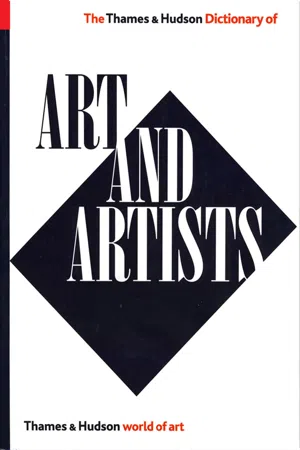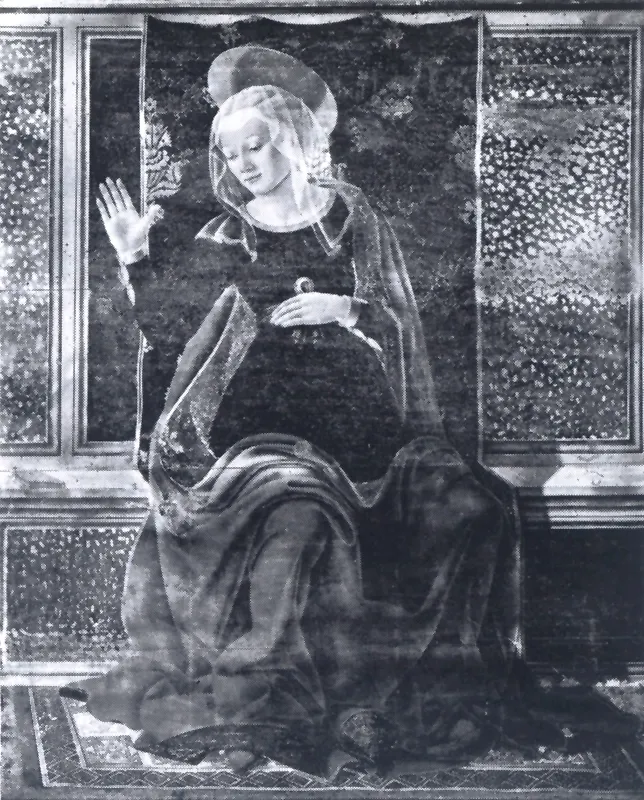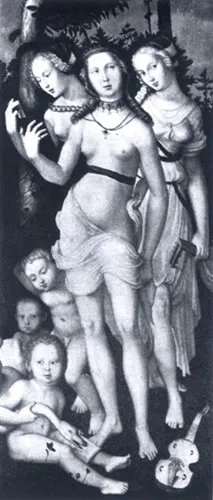
This is a test
- English
- ePUB (mobile friendly)
- Available on iOS & Android
eBook - ePub
The Thames & Hudson Dictionary of Art and Artists
Book details
Book preview
Table of contents
Citations
About This Book
International and up to date, this extensively illustrated and cross-referenced dictionary provides information on over 2500 artists, paintings, sculptures, drawings, prints, schools and movements, including unique information on contemporary art and artists, and on techniques, materials and. Includes over 200 new entries.
Frequently asked questions
At the moment all of our mobile-responsive ePub books are available to download via the app. Most of our PDFs are also available to download and we're working on making the final remaining ones downloadable now. Learn more here.
Both plans give you full access to the library and all of Perlego’s features. The only differences are the price and subscription period: With the annual plan you’ll save around 30% compared to 12 months on the monthly plan.
We are an online textbook subscription service, where you can get access to an entire online library for less than the price of a single book per month. With over 1 million books across 1000+ topics, we’ve got you covered! Learn more here.
Look out for the read-aloud symbol on your next book to see if you can listen to it. The read-aloud tool reads text aloud for you, highlighting the text as it is being read. You can pause it, speed it up and slow it down. Learn more here.
Yes, you can access The Thames & Hudson Dictionary of Art and Artists by Herbert Read, Nikos Stangos in PDF and/or ePUB format, as well as other popular books in Art & Art General. We have over one million books available in our catalogue for you to explore.
Information
Topic
ArtSubtopic
Art GeneralB
Baader Johannes (1876–1955). One of the founding members of the Berlin Dada group. He made primarily collages and photomontages (e.g. Dada Milchstrasse, 1918–20).
Baan Jan van (1633–1702). Dutch portrait painter who visited the court of Charles II of England.
Baburen Dirck van (c. 1590–1624). Dutch painter, one of the principal members of the Utrecht school. For a short period he worked in Rome, where he was affected by the work of Caravaggio; he was one of the first to introduce Caravaggio’s chiaroscuro technique into the Netherlands. Tenebrist.
Bacchiacca Francesco Ubertini (1494–1557). Florentine painter, probably a pupil of Perugino but with an eclectic style most heavily influenced by Andrea del Sarto. B. painted religious subjects and decorative panels for walls or furniture, and designed tapestries.
Baciccia (Baciccio). Nickname of Giovanni Battista Gaulli (1639–1709), one of the finest Italian Baroque portrait painters and decorators. His style was influenced by Rubens and Van Dyck. Working in Rome, where he was a friend of Bernini, he produced masterpieces of illusionist decorative work, notably the ceiling of the church of II Gesù (1668–83).
Backer Jacob Adriaensz (1608–51). Dutch portrait painter and pupil of Rembrandt whose influence on him was strong. He was also influenced by the work of Hals.
Backhuysen Ludolf (1631–1708). Dutch painter chiefly of marine subjects, whose Boats in a Storm may have influenced Turner. Peter the Great of Russia took some lessons from B.
Backof(f)en Hans (d. 1519). German late Gothic sculptor, from 1505 active in Mainz. His work includes the tomb of Archbishop Uriel von Gemmingen (Mainz cathedral) and Crucifixion groups in the churchyards of St Peter’s and the cathedral, Frankfurt.
Bacon Francis (1909–92). Born in Dublin of British parents, he moved to London in 1925, and soon after left Britain to live in Berlin and Paris. He settled permanently in London c. 1928–9. After working first as an interior designer, he began to paint c. 1930 without formal training, and without much success at first. But ever since 1944 with his Three Studies for Figures at the Base of a Crucifixion, he has held a central position in British painting and world figurative art. His paintings are usually of a male or female figure set in an enclosed interior space. The scenes depicted with distorted figures in action often seem disturbing and are frequently presented in three panels, as triptychs – a format B. has virtually invented in modern painting – relating in formal rather than narrative manner. Often ideas for pictures originate in an existing visual source: X-ray photographs, Eadweard Muybridge’s sequential studies of figures in motion, photographs and film stills. B.’s response to the art of the past which he admires deeply is for the paintings of Rembrandt, Velázquez and Goya (e.g. the series of screaming popes which he began in the mid-1950s based on Velázquez’s portrait of Pope Innocent X, which are also related to the ‘still’ of the screaming nurse in Eisenstein’s film The Battleship Potemkin, and the detail of the woman screaming in Nicolas Poussin’s The Massacre of the Holy Innocents). B.’s paintings are not, however, solely about subject matter; he is a perfectionist concerning technique, seeking a balance between chance and order in the way images are built up ‘accidentally’ from the application of paint on canvas.
Bacon John (1740–99). British porcelain modeller and sculptor. He began working in marble in 1763 and improved the method for transferring the design of the clay model to the stone. He became a fashionable society sculptor of tombs and monuments, e.g. the Chatham monument in Westminster Abbey.
Bad art. Neo-Expressionism
Badger Joseph (1708–65). American colonial painter. His style combines primitive elements with the academic post-Kneller tradition of Smibert and Feke. His works include The Rev. Jonathan Edwards and Mrs Cassius Hunt.
Baglione Giovanni (c. 1573–1644). Italian late Mannerist painter and the author of a history of art in Rome during his lifetime, Le vite de’ pittori, scultori ed architetti … (1642). In spite of the hostility he expressed towards Caravaggio, his own painting c. 1600 acquired a superficial likeness to Caravaggio’s. He was one of the artists commissioned by Pope Paul V to paint frescoes in the church of S. Maria Maggiore, Rome.
Baily Edward Hodges (1788–1867). British sculptor. He studied under Flaxman. Carved reliefs on Marble Arch, London, and Nelson’s statue at Trafalgar Square, as well as numerous busts.
Baj Enrico (1924–2003). Italian painter and maker of assemblages incorporating found objects, and combining humour and grotesque imagery.
Bakst Léon (1866–1924). Russian artist and stage designer. After studying in Paris (1893) he returned to St Petersburg, where with Benois and S. Diaghilev he collaborated on the magazine Mir Iskusstva (The World of Art). In 1909 he went to Paris and joined Diaghilev’s Ballets Russes. Here his sets for the ballets Cléopâtre (1909) and above all Schéhérazade (1910) caused a sensation. B.’s designs, characterized by throbbing colours and exotic line, were the first to integrate costumes and sets into a visual unity. Other designs were for Nijinsky’s ballet Le Spectre de la rose (1911), G. D’Annunzio’s play La Pisanella and the ballet The Sleeping Princess (1921).
Bakuba also called Bushongo. African tribal people of the Congo-Kinshasa, noted for one of the finest of African sculptural traditions. Outstanding are a series of royal portrait wood-carvings of which the most famous is that of the 16th-c. king Shamba Bolongongo.
Baldessari John (1931– ). U.S. artist who makes expansive use of media imagery from photographs, videos and film, sometimes associated with Conceptual and Postmodern art. B. has said that he wants ‘to produce images that startle one into recollection’.
Baldinucci Filippo (c. 1624–96). Florentine art historian. In the course of his studies he made a huge coll. of drawings (now in the Uffizi) and used documents more than Vasari had done. His chief work was Notizie de’ professori del disegno … (1681–1728), which covered the period 1260 to 1670.
Baldovinetti Alesso (c. 1425–99). Florentine painter; studied under Domenico Veneziano. His surviving masterpiece, the fresco of the Annunciation, S. Annunziata, Florence, shows his interest in landscape, the serenity of his figures and the sensitivity of his colour. B. executed work in stained glass and mosaic. He influenced Ghirlandaio.

Baldovinetti The Virgin (detail from Annunciation fresco) 1460–2
Balduccio Giovanni da (fl. 1315–49). Italian sculptor from Pisa.
Baldung (Grien) Hans (c. 1480–1545). German painter and graphic artist. He was influenced by Dürer, under whom he probably studied, and indeed in his portraits he showed a psychological insight and mastery of drawing comparable to his master’s. Besides portraits he painted allegorical subjects and, like Cranach, a series of female nudes; but his fame rested on his religious paintings, and the altarpiece The Coronation of the Virgin (1512–16), in the cathedral at Frieburg im Breisgau, is still considered his masterpiece. His paintings are characterized by their unusual colour combinations and his woodcuts by their inventiveness, fantasy and grotesque humour. He also designed for stained glass.

Baldung Harmony 1529
Balen Hendrik van (1575–1632). Antwerp painter of small and charming landscapes, allegorical, biblical and mythological scenes. He collaborated with J. Bruegel the Younger, Momper and Vranckz. Van Dyck and Snyders were his pupils.
Balestra Antonio (1666–1740). Italian late Baroque painter, pupil of Maratta. He worked chiefly in Venice and Verona and was influential as a teacher.
Ball Hugo (1886–1927). German painter and poet who went to Switzerland at the beginning of World War I. He was one of the founders of the Dada movement and ed. of the 1st Dada review, Cabaret Voltaire. In 1917 he quarrelled with Tzara and left the movement.
Balla Giacomo (1871–1958). Italian painter, a founder of Futurism; one of the signatories of the Futurist Manifesto (1910). On a visit to Paris (1900) he was strongly affected by the Impressionist and Divisionist painters. B.’s Dog on a Leash (1912), as an attempt to present motion by superimposing several images, is a logical exposition of Futurism; but his pictures developed towards abstract art, increasingly resolving into abstract lines of movement and force.
Balthus full name Balthasar Klossowski de Rola (1908–2001). French painter of Polish descent. His early work owed much to Bonnard and the Nabis. Later, under the influence of Courbet and Derain, he developed a style which is naturalistic and yet modern, with occasional Surrealist overtones. Using muted colours, B. has produced remarkable landscapes, portraits and interiors with erotic scenes of adolescent girls.
Baluba. Complex of African tribal peoples of Congo-Kinshasa. They are noted for their carvings of which the wooden ancestor figures by the sculptors of the central Hemba tribe are outstanding. Also important are stools supported by carved kneeling female figures; seated female figures holding bowls, notably examples from the N.E. village of Buli; and hemispherical kifwebe masks.
Bambara. W. African people, settled on the Upper Niger in the modern state of Mali, noted for their carving. The tijiwara ritual headdresses, used in the antelope dance, are especially prized.
Bambocciata (It. jest). A genre of painting which deals with peasant life and bawdy scenes. 17th-c. Dutch and Flemish artists were particularly given to it.
Bamboo painting. Chinese art
Bandinelli Baccio (sometimes called ‘Bartolommeo’) (1493–1560). Florentine sculptor, painter and goldsmith. The much-hated rival of B. Cellini and i...
Table of contents
- FOREWORD
- ABBREVIATIONS
- A
- B
- C
- D
- E
- F
- G
- H
- I
- J
- K
- L
- M
- N
- O
- P
- Q
- R
- S
- T
- U
- V
- W
- Y
- Z
- ACKNOWLEDGMENTS